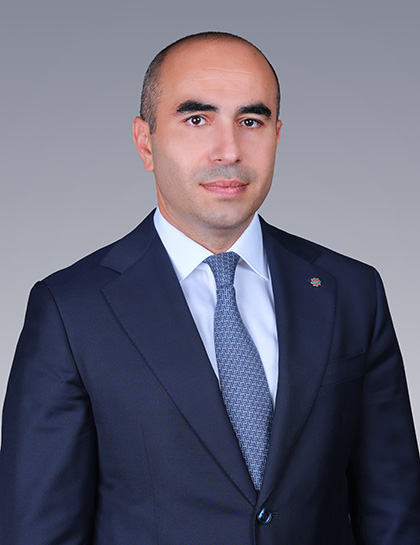PASHA Bank is one of Azerbaijan's leading corporate banks. Established in 2007, we offer all major financial services, including investment banking, trade financing and asset management to a range of clients, from large corporates to small and medium enterprises. The Bank particularly works closely with companies operating in the non-oil sectors of the economy, including agriculture, transportation, construction and retail, which are vital for helping Azerbaijan to diversify its economy.
PASHA Bank is the one of the top 3 banks by assets in Azerbaijan. As of 31 December, 2023, the Bank's consolidated assets exceeded AZN* 8,893 million, while its total capital amounted to AZN 833 million. More detailed information on the Bank's financial figures can be found in the ‘Financial reports’ section.
PASHA Bank is headquartered in Baku and has a total of 5 business centres, 3 branches across Azerbaijan. In 2013, we opened our first office in Georgia and office in Turkey in 2014. Our long-term regional vision envisages creating interconnected banking operations that will facilitate rapidly growing trade and deal flow between Baku, Tbilisi and Istanbul, the three most vibrant markets of the region.
By operating on a solid financial base, moving forward with determination and adding value to the future of both its customers and employees, PASHA Bank Turkey aims to be recognized as an international bank. The bank is rapidly expanding its activities by providing corporate and commercial banking, investment banking, interregional operations, trade finance, consulting services, local currency exchange operations, leasing and other banking services.
PASHA Bank Georgia provides services to large, medium and small enterprises in the field of corporate and investment banking. By identifying the interests of its customers as a key element of its corporate strategy, the Bank has chosen a course of action aimed at sustainable growth. The Bank offers credit, deposit, trade finance, treasury operations (securities, currency exchange, forward, swap, option), internet banking and other products.
We strive to be the best performing and most reliable bank in our country and we have gained international recognition for our achievements. EMEA Finance Magazine granted PASHA Bank with the title of the ‘The Best Investment Bank of Azerbaijan' in 2011, 2012 and 2013. At EMEA Finance Magazine's Europe Banking Awards 2013, PASHA Bank won the award for ‘Best Corporate Social Responsibility (CSR) Program'. In addition, Private Banking divison of PASHA Bank was named as the ‘Best Private Bank in Azerbaijan 2013' by World Finance magazine. EMEA Finance Europe Banking Awards identified PASHA Bank as the “The Best Bank of Azerbaijan” in 2014-2015. PASHA Bank received the Trade Award 2014 from Commerzbank AG for being Azerbaijan's most active bank in the area of trade finance in 2014.
The Global Finance identified PASHA Bank as the Best Bank in Azerbaijan in 2016. World Finance selected PASHA Bank as the winner in nominations of the Best Banking Group and the Best Commercial Bank in 2016. In 2017, PASHA Bank was the winner of the "Best Bank in Azerbaijan" award of Euromoney financial magazine. Within the confines of the Europe Banking Awards, EMEA Finance awarded PASHA Bank with the nominations of "The Best Bank in Azerbaijan", "The Best Investment Bank in Azerbaijan" and "Corporate Social Responsibility in CEE & CIS". Global Finance Magazine called PASHA Bank as the Best Bank in Azerbaijan in 2017. In 2018, PASHA Bank was granted with the title of the “Best Private Bank” and “Best Bank of Azerbaijan” by Global Finance, and received “Sap Value Award”. In the same year, Bank was chosen as the “Best Commercial Bank of Azerbaijan” by World Finance and “Bank of the Year” by The Banker.
According to final results of 2018, PASHA Bank was selected as the winner on the category of “Non-cash payments at POS terminals” and “Contactless payment cards” among the top 3 leading financial institutions within the framework of competition conducted on annual basis by the Central Bank of Azerbaijan together with the Azerbaijan Banks Association, among all participants of the banking segment.
In 2019, PASHA Bank became the winner of the nominations “Best Corporate Social Responsibility” and “Most Active Education Supporter”. In 2020, Bank received the awards for “Cashless Payments Promotion”, “Digital Banking”, “E-Banking”, “Best Corporate Social Responsibility” and “Most Active Education Supporter”. At the same time, PASHA Bank was named as the "Leading Bank in Internet Banking Services", "Leading Bank in Contactless Payments" and "Leading Bank in Contactless POS-Terminal Infrastructure".
In 2020, EMEA Finance granted PASHA Bank with the title of "The Best Bank of Azerbaijan” and “The Best Investment Bank of Azerbaijan”. The Bank became the winner in the nominations "Best Banking Product" and "Best Corporate Social Responsibility program" among financial institutions operating in Central and Eastern Europe and the CIS.
In 2021, the PASHA Bank's "Online Loan" product was chosen as the "Best Banking Product" for SMEs in the region. In the same year, Bank was named as a "Best F2F Acquirer" in Azerbaijan.
In 2022 and 2023, PASHA Bank, Azerbaijan's leading corporate finance institution, received numerous prestigious titles and awards. It was twice nominated by Visa as "Best F2F Acquirer" and earned three awards for "Strong support of the World of privileges", "The highest growth of B2B connect" and "First co-brand with MNO Azercell". PASHA Bank also won several categories in the "Banking Awards" organized by the Azerbaijan Banks Association (ABA), including "CSR", "Financial awareness support", "Promotion of non-cash payments", "Electronic banking projects", and "Educational projects on security in digital payments". Furthermore, PASHA Bank was acknowledged for its efforts to improve financial accessibility, winning the "Participation in the Self-Employment Program" category. The Bank was honored at the "Wasteless Azerbaijan" event for its environmental and CSR initiatives. Finally, in 2024, PASHA Private Banking won the "Best Private Bank in Azerbaijan 2024" nomination in Global Finance's "World's Best Private Banks" competition.
PASHA Bank has received strong rating from international rating agency. In 2023, Standard & Poor's reaffirmed the Bank’s a long-term rating of 'BB-' and a short-term rating of 'B'.
Today, PASHA Bank is an international team of more than 1.200 people. We are constantly working to transform the Bank into one of the biggest and leading financial institutions of the region and to enhance the range of international standard products and services that we already offer.
We are part of PASHA Group, a large investment holding based in Azerbaijan, which has assets across a wide variety of sectors, including retail banking, insurance, construction and tourism. As one of Azerbaijan's youngest but largest banks, we constantly keep abreast of financial and technological innovations. We work hard to keep ahead of market trends and adopt international experience and state-of-the-art technology to ensure that we provide the best possible service to our customers.
*1 USD - 1.7 AZN (01.03.2023)





























